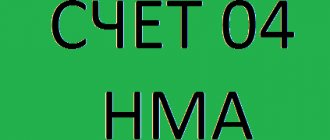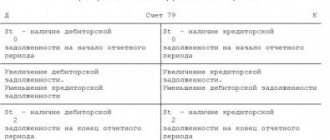What is account 69 used for in accounting?
The law obliges every employer to pay contributions to social funds on almost all remunerations (salaries) of its employees. Let's look at what it is.
Contributions to the funds are mandatory payments that guarantee each employee medical care, pensions, and insurance compensation in case of disability.
There are currently four types of such contributions:
- To the Pension Fund;
- To the social insurance fund - divided into two, payment of disability and compensation for injuries;
- To the health insurance fund.
Attention!
Since 2020, the Federal Tax Service has been managing these contributions (except for injuries). They are transferred by the 15th of each month in separate payment orders. To carry out accounting of accrued and paid amounts for each type of contribution in the chart of accounts, account 69 “Calculations for social insurance and security” is used. Since this information is widely used to fill out various reports, it is necessary to organize accounting in the context of each fund, as well as the type of transfer to it (contribution, fine, penalty, etc.).
Active or passive
Account 69 is used to record accrued and paid contributions to extra-budgetary funds.
Sub-accounts can be opened for it, which are divided according to the purpose of payment. This account can be used for transactions:
- on the calculation of contributions - penalties, penalties;
- when paying accrued penalties, fines, etc.;
- recording in the reporting documentation the amount of expenses for paying contributions to extra-budgetary funds.
From 01/01/2017, in accordance with the adopted changes in the legislation of the Russian Federation, all payments between the organization and the VNF will be carried out with the help of the branches of the Federal Tax Service. The exception is calculations in the event of an employee being injured at work.
Main type subaccounts:
- Sbsch. 69.1 - is responsible for recording information on transactions between the company, the Federal Tax Service and the Social Insurance Fund.
- Sbsch. 69.02 – displays settlements with the Pension Fund.
- Sbsch.69.03 – contributions to the Federal Tax Service on account of medical insurance companies.
Count 69 is active-passive. For debit, information on completed payments is displayed, and for credit, charges (their generalized amount) are displayed.
Account characteristics
Let's consider the characteristics of account 69, as well as what is reflected in debit and credit.
Considering the order in which transactions are reflected helps determine whether this is an active or passive account. The debit of the account records transactions involving the transfer of contributions, and the credit records their accrual.
Since at any given time there can be either an overpayment of any contribution (debit balance) or an underpayment (credit balance), this indicates that the account is active-passive.
Attention! When determining the final score, it is necessary to take into account which side of the account the initial one is on. If it is in debit, then this balance must be added to the debit turnover and subtracted from the credit turnover. A positive balance will show a debit ending balance, a negative balance will show a credit balance, which is reflected without a negative sign.
In the balance sheet, account balances 69 are reflected in two places at once:
- Debit on line 1260 “Other current assets” in the asset;
- Credit on line 1550 “Other liabilities” in liabilities.
What does account credit 69 show?
The loan reflects business transactions related to the calculation of mandatory insurance contributions, including fines and penalties. That is, the credit of account 69 shows what the current debt of the employer-insurer to state funds and the tax office related to insurance and social security is.
At the same time, the amount of transferred insurance premiums is reflected in the debit of the account. A debit balance means that the company has overpaid insurance premiums.
To better understand what type of mandatory insurance premiums the overpayment or debt arose for, you should study account 69 for subaccounts. For this purpose, analytical accounting must be maintained.
Subscribe to our newsletter
Read us on Yandex.Zen Read us on Telegram
Subaccounts
The chart of accounts recommends opening three subaccounts for this account:
- 69/1 “Calculations for social insurance”
- 69/2 “Calculations for pension provision”
- 69/3 “Calculations for compulsory health insurance.”
You might be interested in:
Payment of dividends to LLC founders: foundations in 2020, tax rate, step-by-step instructions
At each of them, amounts are recorded in a separate type of insurance fund. In addition, organizations are also required to make transfers to the injury fund.
To account for these amounts, you can open another subaccount 69/4 “Calculations for contributions for injuries”, or split subaccount 69/1 into two separate accounts:
- 69/1/1 - Calculations for social insurance contributions;
- 69/1/2 - Calculations for contributions for injuries.
Also, for late or incomplete payment of contributions, the regulatory authority may impose fines or penalties. It is recommended to account for these amounts in separate sub-accounts opened for each type of transfer to social funds.
Attention! If there are other types of deductions, subaccounts can be opened for them. For example, if voluntary contributions from employees to pensions are transferred.
Typical wiring
Account 69 can correspond with the following accounts.
From the debit of account 69 to the credit of accounts:
- Account 50 - used in certain cases when social benefits are issued from the cash register. Moreover, such an entry can only be made in situations where the benefit is not combined with salary payments and is calculated bypassing account 70. In addition, they should not be subject to taxes and other deductions.
- Account 51 - when transferring contributions from a current account;
- Account 52 - when transferring contributions from a foreign currency account. Despite the fact that such correspondence is directly indicated in the chart of accounts adopted by Order 94-N, it is unlikely in real life, since payments to the budget must be made in rubles.
- Account 55 - when transferring contributions to social funds from open special accounts;
- Account 70 - when calculating benefits to employees at the expense of social funds.
According to the credit of the account, it corresponds with the debit of the following accounts:
- Account 08 - when calculating contributions to employees involved in preparing capital investment objects for operation;
- Account 20 - when calculating contributions to employees engaged in the main production;
- Account 23 - when calculating contributions to employees engaged in auxiliary production;
- Account 25 - when calculating contributions to general production employees;
- Account 26 – when calculating contributions to administrative employees;
- Account 28 - when calculating contributions to employees involved in correcting a previously committed defect;
- Account 29 – when calculating contributions to employees employed in service industries and farms;
- Account 44 - when calculating contributions to employees involved in the sale of finished products or services;
- Account 51 - when crediting excess funds transferred to funds, compensation, etc. to the current account.
- Account 52 - When crediting money, compensations, etc., excessively transferred to funds to a foreign currency account. Despite the fact that such correspondence is directly indicated in the chart of accounts adopted by Order 94-N, it is unlikely in life, since budget payments must be made in rubles.
- Account 70 - When deducting from the employee part of the cost of sanatorium treatment allocated by the social insurance fund;
- Account 73 - when withholding penalties and fines issued by social funds from the guilty person;
- Account 91 - when calculating contributions to employees not directly involved in the production of products or provision of services;
- Account 96 - when accruing contributions for the amount of vacations, employees undergoing warranty repairs, at the expense of previously formed reserves;
- Account 97 - when accruing to amounts of wages that are paid in one period, but are recognized in accounting in the subsequent period.
- Account 99 - when reflecting contributions for wages paid in connection with the liquidation of the consequences of natural disasters. The same entry is drawn up when reflecting accrued fines and penalties for payments to social funds.
You might be interested in:
Postings for wages and taxes: how to reflect them correctly in 2020
Regulatory framework and analytical analysis
For each type of deduction, reconciliation of mutual settlements takes place under the strict control of authorized bodies. The procedure is carried out in accordance with the current account of which VNF the deductions will be made and the type of payment made. The data indicated on the account must completely coincide with the information from the certificate issued by the Federal Tax Service.
The rules for using account 69 to record information on settlements between an enterprise, the tax authority and extra-budgetary funds are regulated by the Chart of Accounts, Order of the Ministry of Finance of the Russian Federation No. 94 of October 31, 2000, Federal Law No. 243 and other legislative acts.
Posting examples
When calculating insurance premiums, they must be charged to the same cost account where the salary of the same employee is taken into account. The transfer of contributions to the budget is carried out by various payment orders indicating the BCC of the corresponding fund. Let's consider further examples of drawing up postings for dummies.
Calculation of insurance premiums
| Debit | Credit | Operation designation |
| 08, 20, 23, 25, 26, 29, 44, 91/2, 96, 97 | 69 subaccount “Pension insurance” | Contributions for employee pension insurance have been calculated |
| 08, 20, 23, 25, 26, 29, 44, 91/2, 96, 97 | 69 subaccount "Medstrakh" | Contributions to the health insurance fund have been calculated |
| 08, 20, 23, 25, 26, 29, 44, 91/2, 96, 97 | 69 subaccount "Social Insurance" | Contributions to the social insurance fund for temporary disability and maternity have been calculated |
| 08, 20, 23, 25, 26, 29, 44, 91/2, 96, 97 | 69 subaccount “Injuries” | Contributions for insurance against accidents and injuries have been calculated |
Transfer of insurance premiums
| Debit | Credit | Operation designation |
| 69 subaccount “Pension insurance” | 51 | Employee pension insurance contributions transferred non-cash |
| 69 subaccount "Medstrakh" | 51 | Contributions to the health insurance fund were transferred non-cash |
| 69 subaccount "Social Insurance" | 51 | Contributions to the social insurance fund for temporary disability and maternity were transferred non-cash |
| 69 subaccount “Injuries” | 51 | Payments for insurance against accidents and injuries are transferred non-cash |
Other transactions with insurance premium funds
| Debit | Credit | Operation name |
| 69 subaccount “Injuries” | 70 | A payment was made from the fund due to a work-related injury. |
| 69 subaccount "Social Insurance" | 70 | Sick leave payments have been accrued |
| 99 | 69 subaccount “Pension insurance” | Reflects the accrual of penalties for late payment of employee pension insurance contributions |
| 99 | 69 subaccount "Medstrakh" | Reflects the accrual of penalties for late payment of contributions to the health insurance fund |
| 99 | 69 subaccount "Social Insurance" | Reflects the accrual of penalties for late payment of contributions to the social insurance fund for temporary disability and maternity |
| 99 | 69 subaccount “Injuries” | Reflects the accrual of penalties for late payment of accident and injury insurance premiums |











